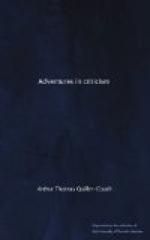And, now you have it, doesn’t it look rather like Bitzer’s horse?
“Bitzer,” said Thomas Gradgrind. “Your definition of a horse?”
“Quadruped. Graminivorous. Forty teeth, namely twenty-four grinders, four eye-teeth, and twelve incisive. Sheds coat in the spring; in marshy countries sheds hoofs too. Hoofs hard, but requiring to be shod with iron. Age known by marks in mouth.” Thus (and much more) Bitzer.
* * * * *
March 30, 1895. The Texts of the “Canterbury Tales.”
It follows, I hope, from what I said last week, that by far the most important service an editor can render to Chaucer and to us is to give us a pure text, through which the native beauty of the poetry may best shine. Such a text Professor Skeat has been able to prepare, in part by his own great industry, in part because he has entered into the fruit of other men’s labors. The epoch-making event in the history of the Canterbury Tales (with which alone we are concerned here) was Dr. Furnivall’s publication for the Chaucer Society of the famous “Six-Text Edition.” Dr. Furnivall set to work upon this in 1868.
The Six Texts were these:—
1. The great “Ellesmere”
MS. (so called after its owner, the Earl
of Ellesmere).
“The finest and best of all the MSS. now extant.”
2. The “Hengwrt”
MS., belonging to Mr. William W.E. Wynne, of
Peniarth; very closely
agreeing with the “Ellesmere.”
3. The “Cambridge”
MS. Gg 4.27, in the University Library. The
best copy in any public
library. This also follows the
“Ellesmere”
closely.
4. The “Corpus”
MS., in the library of Corpus Christi College,
Oxford.
5. The “Petworth” MS., belonging to Lord Leconfield.
6. The “Lansdowne”
MS. in the British Museum. “Not a good MS.,
being certainly the
worst of the six; but worth reprinting owing
to the frequent use
that has been made of it by editors.”




